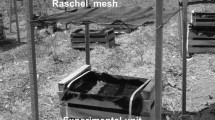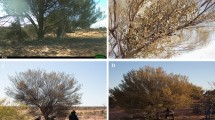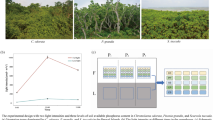Abstract
The canopy shade of the Retama species has been widely reported to ameliorate the environmental conditions in the understory, thus facilitating other species’ establishment. The shading effect of the native-invasive leguminous shrub Retama monosperma (L.) Boiss on the endangered Thymus carnosus Boiss was analysed to determine a positive or negative net effect. Data was taken in all four seasons, representing contrasting light and water availability in a Mediterranean coastal dune ecosystem (SW Spain). The morphological and physiological status of sun-exposed T. carnosus plants growing in open areas versus shaded plants growing under R. monosperma were measured seasonally. Leaf mass area, leaf area index and pigment content showed typical sun–shade responses. In contrast, sun-exposed T. carnosus displayed higher stem water potential, transpiration rate and water use efficiency, both intrinsic and integrated, denoting low tolerance to the presence of R. monosperma. Five years after the measurements, canopy cover had decreased and mortality was higher in shaded plants, thus confirming the competitive effect of R. monosperma on T. carnosus. R. monosperma arises as a competitor for endangered T. carnosus communities, consequently reinforcing its invasive behaviour. This species-specific shrub study demonstrates that eventual beneficial effects of Retama canopy may be overridden by competition in the understory, particularly in the case of species well-adapted to high light and low water levels.









Similar content being viewed by others
References
Alpert P, Bone E, Holzapfel C (2000) Invasiveness, invasibility and the role of environmental stress in the spread of non-native plants. Perspect Plant Ecol 3:52–66
Álvarez-Cansino L, Zunzunegui M, Díaz Barradas MC, Esquivias MP (2010) Physiological performance and xylem water isotopic composition underlie gender-specific responses in the dioecious shrub Corema album. Physiol Plant 140:32–45
Anonymous (1992) Directive 92/43/CEE on the conservation of natural habitats and of wild fauna and flora. European Communities Council, Brussels
Armas C, Pugnaire FI (2005) Plant interactions govern population dynamics in a semi-arid plant community. J Ecol 93:978–989
Armas C, Pugnaire FI (2009) Ontogenetic shifts in interactions of two dominant shrub species in a semi-arid coastal sand dune system. J Veg Sci 20:535–546
Balaguer L, Pugnaire FI, Martínez-Ferri E, Armas C, Valladares F, Manrique E (2002) Ecophysiological significance of chlorophyll loss and reduced photochemical efficiency under extreme aridity in Stipa tenacissima L. Plant Soil 240:343–352
Björkman O, Powles SB (1984) Inhibition of photosynthetic reactions under water stress, interaction with light level. Planta 161:490–504
Brooker RW, Maestre FT, Callaway RM, Lortie CJ, Cavieres LA, Kunstler G, Liancourt P, Tielbörger K, Travis JMJ, Anthelme F, Armas C, Coll L, Corcket E, Delzon S, Forey E, Kikvidze Z, Olofsson J, Pugnaire FI, Quiroz CL, Saccone P, Schiffers K, Seifan M, Touzard B, Michalet R (2008) Facilitation in plant communities: the past, the present, and the future. J Ecol 96:18–34
Cabezudo B, Talavera S, Blanca G, Salazar C, Cueto M, Valdés B, Hernández Bermejo JE, Herrera CM, Rodríguez Hiraldo C, Navas D (2005) Lista Roja de la Flora Vascular de Andalucía. Consejería de Medio Ambiente, Junta de Andalucía, Sevilla
Cal-IPC (2006) California Invasive Plant Inventory. Cal-IPC Publication 2006-02. California Invasive Plant Council, Berkeley, CA. http://www.cal-ipc.org/paf. Accessed 11 Apr 2014
Callaway RM (1995) Positive interactions among plants. Bot Rev 61:306–349
Callaway RM, Pugnaire FI (1999) Facilitation in plant communities. In: Pugnaire FI, Valladares F (eds) Handbook of functional plant ecology. Marcel Dekker, New York, pp 623–648
Callaway RM, Walker LR (1997) Competition and facilitation: a synthetic approach to interactions in plant communities. Ecology 78:1958–1965
Callaway RM, Nadkarni NM, Mahall BE (1991) Facilitation and interference of Quercus douglasii on understory productivity in central California. Ecology 72:1484–1499
Damesin C, Rambal S, Joffre R (1997) Between-tree variations in leaf δ13C of Quercus pubescens and Quercus ilex among Mediterranean habitats with different water availability. Oecologia 111:26–35
Dawson TE, Mambelli S, Plamboeck AH, Templer PH, Tu KP (2002) Stable isotopes in plant ecology. Annu Rev Ecol Syst 33:507–559
Dellafiore CM, Muñoz Vallés S, Gallego Fernández JB (2006) Rabbits (Oryctolagus cuniculus) as dispersers of Retama monosperma (L.) Boiss. seeds in a coastal dune system. Ecoscience 13:5–10
Dellafiore CM, Gallego Fernández JB, Muñoz Vallés S (2008) Habitat use for warren building by European rabbits (Oryctolagus cuniculus) in relation to landscape structure in a sand dune system. Acta Oecol 33:372–379
DeLucia EH, Heckathorn SA (1989) The effect of soil drought on water-use efficiency in a contrasting Great Basin desert and Sierran montane species. Plant, Cell Environ 12:935–940
Demmig-Adams B, Adams WW III (1996) The role of xanthophylls cycle carotenoids in the protection of photosynthesis. Trends Plant Sci 1:21–26
Ehleringer JR, Cooper TA (1988) Correlations between carbon isotope ratio and microhabitat in desert plants. Oecologia 76:562–566
Esquivias MP, Zunzunegui M, Díaz Barradas MC, Álvarez-Cansino L (2014) The role of water use and uptake on two Mediterranean shrubs’ interaction in a brackish coastal dune ecosystem. Ecohydrology 7:783–793
Farqhuar GD, Richards RA (1984) Isotopic composition of plant carbon correlates with water-use efficiency of wheat genotypes. Aust J Plant Physiol 11:539–552
Farqhuar GD, Ehleringer JR, Hubick KT (1989) Carbon isotope discrimination and photosynthesis. Annu Rev Plant Physiol Plant Mol Biol 40:503–537
Gallego Fernández JB, Muñoz Vallés S, Dellafiore C (2006) Flora and vegetation on Nueva Umbría spit (Lepe, Huelva). Ayto, Lepe
Genty B, Briantais JM, Baker NR (1989) The relationship between the quantum yield of photosynthetic electron transport and quenching of chlorophyll fluorescence. Biochim Biophys Acta 990:87–92
Gutschick VP, Wiegel FW (1988) Optimizing the canopy photosynthetic rate by patterns of investment in specific leaf mass. Am Nat 132:67–86
Hallik L, Niinemets Ü, Wright IJ (2009) Are species shade and drought tolerance reflected in leaf-level structural and functional differentiation in Northern Hemisphere temperate woody flora? New Phytol 184:257–274
Högberg P (1997) 15N natural abundance in soil–plant systems. New Phytol 137:179–203
Holmgren M (2000) Combined effects of shade and drought on tulip poplar seedlings, trade-off in tolerance or facilitation? Oikos 90:67–78
Holmgren M, Gómez-Aparicio L, Quero JL, Valladares F (2012) Non-linear effects of drought under shade: reconciling physiological and ecological models in plant communities. Oecologia 169:293–305
ICN (2006) Plano Sectorial da Rede Natura 2000. Instituto da Conservação da Natureza, Portugal. http://www.icnf.pt/portal/naturaclas/rn2000/p-set/psrn-flora. Accessed 11 Apr 2014
Kith y Tassara M (1946) El problema de las dunas del SO de España. Revista de Montes 11:414–419
Lichtenthaler HK (1987) Chlorophylls and carotenoids, pigments of photosynthetic biomembranes. Methods Enzymol 148:350–382
Llorens L, Peñuelas J, Filella I (2003) Diurnal and seasonal variations in the photosynthetic performance and water relations of two co-occurring Mediterranean shrubs, Erica multiflora and Globularia alypum. Physiol Plant 118:84–95
López-Pintor A, Gómez Sal A, Rey Benayas JM (2006) Shrubs as a source of spatial heterogeneity—the case of Retama sphaerocarpa in Mediterranean pastures of central Spain. Acta Oecol 29:247–255
Maestre FT, Cortina J (2004) Do positive interactions increase with abiotic stress? A test from a semi-arid steppe. Proc R Soc B 271:S331–S333
Maestre FT, Bautista S, Cortina J (2003) Positive, negative, and net effects in a grass–shrub interactions in Mediterranean semiarid grasslands. Ecology 84(12):3186–3197
Maxwell K, Johnson NG (2000) Chlorophyll fluorescence—a practical guide. J Exp Bot 51:659–668
Moriana A, Villalobos FJ, Fereres E (2002) Stomatal and photosynthetic responses of olive (Olea europaea L.) leaves to water deficits. Plant, Cell Environ 25:395–405
Moro MJ, Pugnaire FI, Haase P, Puigdefábregas J (1997) Effect of the canopy of Retama sphaerocarpa on its understory in a semiarid environment. Funct Ecol 11:425–431
Munné-Bosch S, Nogués S, Alegre L (1999) Diurnal variations of photosynthesis and dew absorption by leaves in two evergreen shrubs growing in Mediterranean field conditions. New Phytol 144:109–119
Muñoz Vallés S (2009) Composición y estructura de la vegetación de la Flecha Litoral de El Rompido, Huelva. Estudio de la expansión de Retama monosperma (L.) Boiss. y su efecto sobre las comunidades del sistema dunar. PhD thesis, University of Seville, Seville, Spain
Muñoz Vallés S, Gallego Fernández JB, Dellafiore C (2009) Estudio florístico de la Flecha Litoral de El Rompido (Lepe, Huelva). Análisis y catálogo de la flora vascular de los sistemas de duna y marisma. Lagascalia 29:43–88
Muñoz Vallés S, Gallego Fernández JB, Dellafiore C, Cambrollé J (2011) Effects on soil, microclimate and vegetation of the native-invasive Retama monosperma (L.) in coastal dunes. Plant Ecol 212:169–179
Niinemets Ü, Bilger W, Kull O, Tenhunen JD (1998) Acclimation to high irradiance in temperate deciduous trees in the field, changes in xanthophylls cycle pool size and in photosynthetic capacity along a canopy light gradient. Plant, Cell Environ 21:1205–1218
Padilla FM, Pugnaire FI (2009) Species identity and water availability determine establishment success under the canopy of Retama sphaerocarpa shrubs in a dry environment. Restor Ecol 17:900–907
Poorter H, Niinemets Ü, Poorter L, Wright I, Villar R (2009) Causes and consequences of variation in leaf mass per area (LMA), a meta-analysis. New Phytol 182:565–588
Prider JN, Facelli JM (2004) Interactive effects of drought and shade on three arid zone chenopod shrubs with contrasting distributions in relation to tree canopies. Funct Ecol 18:67–76
Pugnaire FI, Haase P, Puigdefábregas J (1996) Facilitation between higher plant species in a semiarid environment. Ecology 77:1420–1426
Randall JM (1997) Weed alert! New invasive weeds in California. In: Symposium proceedings of the California Exotic Pest Plant Council, CA, pp 1–6
Randall RP (2007) The introduced flora of Australia and its weed status. CRC for Australian Weed Management, Adelaide
Read J, Farquhar G (1991) Comparative studies in Nothofagus (Fagaceae). I. Leaf carbon isotope discrimination. Funct Ecol 5:684–695
Rice WR (1989) Analyzing tables of statistical tests. Evolution 43(1):223–225
Rodríguez-Echevarría S, Pérez-Fernández MA (2003) Soil fertility and herb facilitation mediated by Retama sphaerocarpa. J Veg Sci 14:807–814
Sánchez-Gómez D, Valladares F, Zavala MA (2006) Performance of seedlings of Mediterranean woody species under experimental gradients of irradiance and water availability, trade-offs and evidence for niche differentiation. New Phytol 170:795–806
Scholander PF, Hammer HT, Bradstreet ED, Hemmingsen EA (1965) Sap pressure in vascular plants. Science 148:339–346
Smith T, Huston M (1989) A theory of the spatial and temporal dynamics of plant communities. Vegetatio 83:49–69
Talavera S (1999) Retama Raf. In: Talavera S et al (eds) Flora Ibérica, vol VII. CSIC, Madrid, pp 137–141
Tielbörger K, Kadmon R (2000) Temporal environmental variation tips the balance between facilitation and interference in desert plants. Ecology 81:1544–1553
Valdés B, Girón V, Sánchez Gullón E, Carmona I (2007) Catálogo florístico del Espacio Natural de Doñana (SO de España) Plantas Vasculares. Lagascalia 27:73–362
Valéry L, Fritz H, Lefeuvre JC, Simberloff D (2009) Ecosystem-level consequences of invasions by native species as a way to investigate relationships between evenness and ecosystem function. Biol Invasions 11:609–617
Valladares F, Pearcy RW (1997) Interactions between water stress, sun-shade acclimation, heat tolerance and photoinhibition in the sclerophyll Heteromeles arbutifolia. Plant, Cell Environ 20:25–36
Valladares F, Pearcy RW (1998) The functional ecology of shoot architecture in sun and shade plants of Heteromeles arbutifolia M. Roem., a Californian chaparral shrub. Oecologia 114:1–10
Valladares F, Pearcy RW (2002) Drought can be more critical in the shade than in the sun: a field study of carbon gain and photoinhibition in a Californian shrub during a dry El Niño year. Plant, Cell Environ 25:749–759
Valladares F, Zaragoza-Castells J, Sánchez-Gómez D, Matesanz S, Alonso B, Portsmuth A, Delgado A, Atkin OK (2008) Is shade beneficial for Mediterranean shrubs experiencing periods of extreme drought and late-winter frosts? Ann Bot 102:923–933
Werner C, Correia O, Beyschlag W (2002) Characteristic patterns of chronic and dynamic photoinhibition of different functional groups in a Mediterranean ecosystem. Funct Plant Biol 29:999–1011
Zaragoza-Castells J, Sánchez-Gómez D, Hartley IP, Matesanz S, Valladares F, Lloyd J, Atkin OK (2008) Climate-dependent variations in leaf respiration in a dry-land, low productivity Mediterranean forest: the importance of acclimation in both high-light and shaded habitats. Funct Ecol 22:172–184
Zunzunegui M, Esquivias MP, Oppo F, Gallego-Fernández JB (2012) Interspecific competition and livestock disturbance control the spatial patterns of two coastal dune shrubs. Plant Soil 354:299–309
Acknowledgments
This work was partly funded by the Spanish Ministry of Education and Science (CGL2005-02142). M.P.E. was supported by a FPDI-Junta de Andalucía fellowship. We thank the Regional Environment Ministry of Andalucía for permission to work in the Natural Reserve and with the protected species. We are also grateful to Carlos Pérez, Javier Esquivias, Ana Fernández and Jon Jauregui for field assistance, and to Miguel Clavero for statistical advice. Valuable comments on earlier drafts of this manuscript were provided by Jessica Milgroom and two anonymous reviewers.
Author information
Authors and Affiliations
Corresponding author
Additional information
Communicated by Kouki Hikosaka.
Electronic supplementary material
Below is the link to the electronic supplementary material.
Rights and permissions
About this article
Cite this article
Esquivias, M.P., Zunzunegui, M., Díaz Barradas, M.C. et al. Competitive effect of a native-invasive species on a threatened shrub in a Mediterranean dune system. Oecologia 177, 133–146 (2015). https://doi.org/10.1007/s00442-014-3106-4
Received:
Accepted:
Published:
Issue Date:
DOI: https://doi.org/10.1007/s00442-014-3106-4




